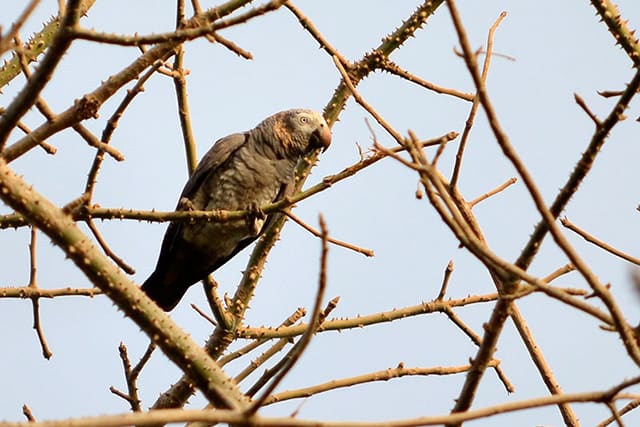Timneh Parrots: Population and Habitat Studies
Status:

Collaborators/Funders:
IBAP (National Institute for Biodiversity and Protected Areas), the Coastal Planning Cabinet of Guinea-Bissau, Dr. Paulo Catry (ISPA – Instituto Universitário, Portugal), Dr. Davide De Guz, The Wara Conservation Project (SALF and GALF programmes), Save Our Species (SOS), ZooMarine Portugal, Whitley Wildlife Conservation Trust, Bridging Peace Foundation, Folke H Peterson Trust, MAVA, Explore Trees
Collecting data on wild populations is vitally important for Timneh Parrot (Psittacus timneh) conservation. Researchers found that populations on Bijagós and Pecixe islands in Guinea-Bissau have declined. WPT-backed surveys carried out in 2018 in Sierra Leone found previously undocumented breeding areas in the coastal regions, suggesting some of the highest numbers of Timneh Parrots known anywhere in their range. Ongoing research has uncovered where populations have declined and identified critical habitat needing protection. It has also highlighted the importance of mangroves to these birds. A report from Liberia suggests another major roosting site with possibly more parrots than the site recently discovered in Sierra Leone. Also in Liberia, new collaborators are building a more comprehensive picture of the broader region and identifying sites for potential reintroduction.
At the end of 2022 a new study, “Building on current knowledge to understand the conservation status and threats impacting the Timneh Parrot population in Liberia,” began. The effort was backed by the WPT and Natural Encounters Conservation Fund.
IUCN/CITES Status: Endangered / Appendix I
Population: 100,000-500,000 mature individuals, decreasing.
Range: Native to the western parts of the moist Upper Guinea forests and bordering savannas of West Africa extending from the Bijagós islands of Guinea-Bissau eastwards through southern Guinea, Sierra Leone, Liberia and Côte d’Ivoire.
Natural history: Is found in primary and secondary rainforest, forest edges and clearings, gallery forest, mangroves and savanna. Diet consists of a variety of seeds, nuts, fruits (including oil palm) and berries. Will sometimes travel great distances for food. Are generally seen in small, but vocal, flocks of a few dozen. Breeding is during the dry season; January-February, and June-July. Nest is in a high, live tree in a hollow.
